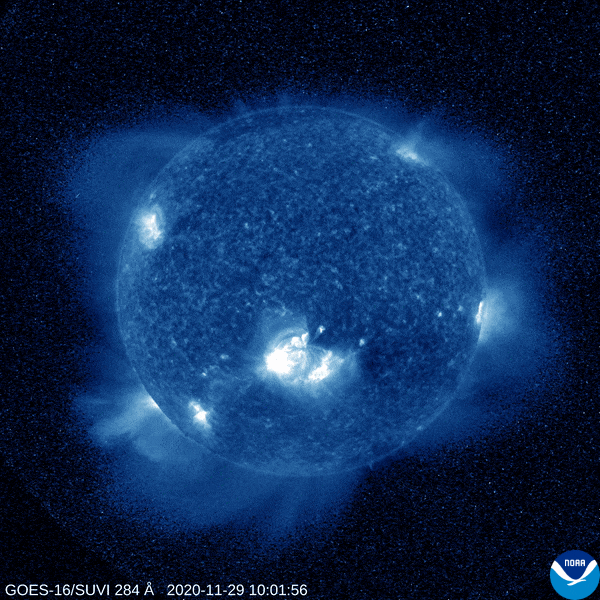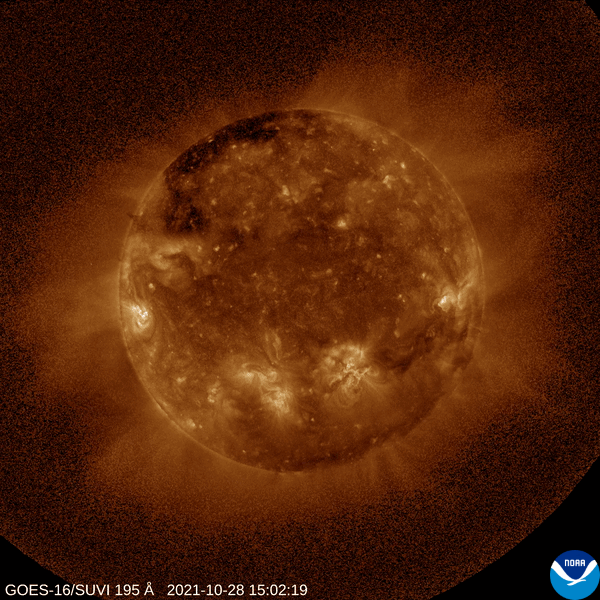Stunning New Images of Solar Activity Released by NOAA
Above - SUVI imagery from NOAA’s GOES-16 satellite of a subsequent CME on July 5-6, 2021 (Credit: NOAA)
The National Oceanic and Atmospheric Administration (NOAA) has released new satellite imagery of the solar cycle - a timelapse over over 3 years from December 2019 to Spring 2023. In the 5 minute timelapse NOAA shared of the solar cycle in the last 3 years they highlighted some of the larger events captured of "Solar Cycle 25".
Solar cycles happen when the sun's magnetic field shifts, roughly every 11 years, when the north and south pole switch. Cycles are determined to start after a lull in solar activity (flares and sunspots) and intensity and peak of these solar cycles have impacts on space weather and felt here on Earth. Some of those impacts include: auroras (geomagnetic storms), radio blackouts and solar radiation storms. The previous solar cycle (Cycle 24) lasted 11 years and NOAA was able to determine the start of Solar Cycle 25 when two pairs of sunspots were captured by satellite and were determined to be opposite of the magnetic fields of Solar Cycle 24.
Some of the notable images included this from late November 2020, when large sunspots (the bright clusters on the sun) appeared in the southern hemisphere. According to NOAA, "[the sun] had 17 sunspots at its peak and covered an area six times the surface of the Earth."

SUVI imagery from NOAA’s GOES-16 satellite on November 29, 2020. (NOAA)
In May 2021, the first geomagnetic storm of Solar Cycle 25 was observed, as a result of a Coronal Mass Ejection (CME) earlier in the month. NOAA ranks geomagnetic storms on a scale of 1 to 5 and a G3 storm as determined below is capable of impacting satellites and producing an aurora visible as far south as Oregon and Illinois in the United States. CME's are created when large clouds of solar plasma are "burped" or "ejected" from the sun in a particular direction.
-1685738009610.gif)
How's this for spooky? NOAA Satellites captured another solar phenomenon - a solar FLARE. This differs from a CME described above, as flares are extremely bright and quick, putting out energy equivalent to billions of hydrogen bombs, according to NASA. Flares can cause additional impacts on earth, including radio blackouts over South America in late October 2021.

SUVI imagery from NOAA’s GOES-16 satellite on October 28, 2021. (NOAA)

Close-up SUVI imagery from NOAA’s GOES-16 satellite on October 28, 2021. (NOAA)
You may remember more recently, a very active Spring with multiple auroras across the northern and central United States during March and April. These are thanks to Solar Cycle 25 as the sun continues to release energy. Though we had activity through all of 2022, the CME on March 23, 2023 produce a level 4 Geomagnetic Storm. According to NOAA, "Electrical power disruptions were reported in several states and aurora was visible in more than half of the U.S., reaching as far south as New Mexico, Missouri and North Carolina." You sent footage of the auroras to WeatherNation and we shared them on-air as beautiful colors were captured across the United States.
Another level 4 geomagnetic storm occurred less than a month later, on April 21 producing another rounds of impressive auroras in the United States.
For the entire article regarding Solar Cycle 25, please visit NOAA's website. For more on space weather forecasts, click here.